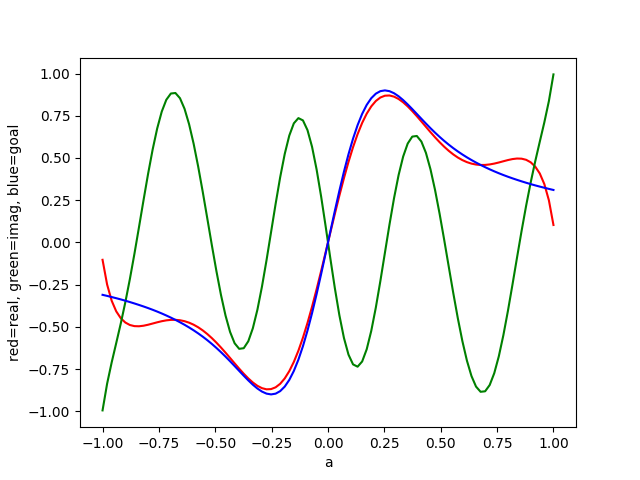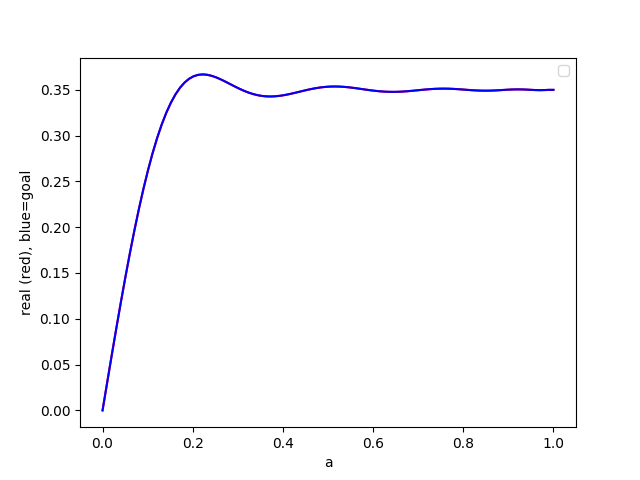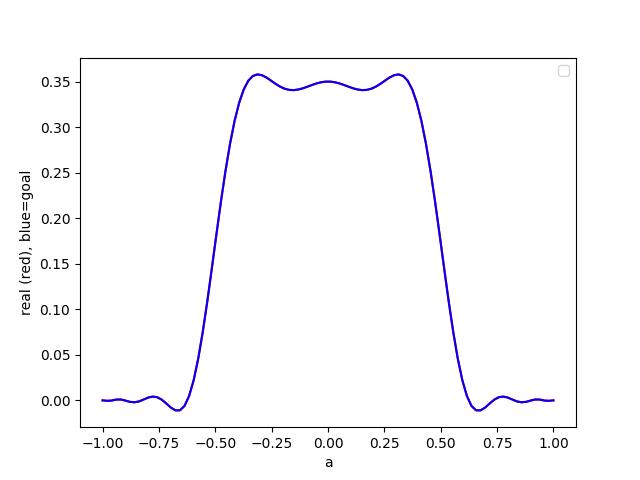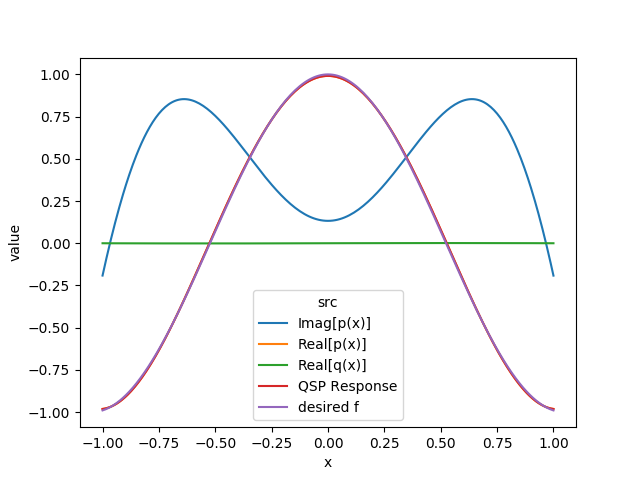Generate phase angles for quantum signal processing algorithms
Project description
Quantum Signal Processing
Introduction
Quantum signal processing is a framework for quantum algorithms including Hamiltonian simulation, quantum linear system solving, amplitude amplification, etc.
Quantum signal processing performs spectral transformation of any unitary U, given access to an ancilla qubit, a controlled version of U and single-qubit rotations on the ancilla qubit. It first truncates an arbitrary spectral transformation function into a Laurent polynomial, then finds a way to decompose the Laurent polynomial into a sequence of products of controlled-U and single qubit rotations (by certain "QSP phase angles") on the ancilla. Such routines achieve optimal gate complexity for many of the quantum algorithmic tasks mentioned above. The task achieved is essentially entirely defined by the QSP phase angles employed in the QSP operation sequence, and as such a central part is finding these QSP phase angles, given the desired Laurent polynomial.
This python package generates QSP phase angles using the code based on two different methods. The "laurent" method employs Finding Angles for Quantum Signal Processing with Machine Precision, and extends the original code for QSP phase angle calculation, at https://github.com/alibaba-edu/angle-sequence. The "tf" method employs tensorflow + keras, and finds the QSP angles using optimization.
QSP conventions
As described in A Grand Unification of Quantum Algorithms, two important QSP model conventions used in the literature are known as Wx, where the signal W(a) is an X-rotation and QSP signal processing phase shifts are Z-rotations, and Wz, where the signal W(a) is a Z-rotation and QSP signal processing phase shifts are X-rotations.
Specifically, in the Wx convention, the QSP operation sequence is:

And in the Wz convention, the QSP operation sequence is:

They are related by a Hadamard transform:

The Wz convention is convenient for and employed in Laurent polynomial formulations of QSP, whereas the Wx convention is more traditional, e.g. as employed in quantum singular value transform applications of QSP.
This package can generate QSP phase angles for both conventions (whereas earlier code only handled the Wz convention). The challenge is that if one wants a certain polynomial 

In addition to specifying the signal rotation operator W and the signal processing operator phase shifts, the QSP signal basis must also be specified. In this code, the default basis is |+>, but the code also allows the |0> basis to be used (when using tensorflow optimization to generate the phase angles). See the "--measurement" option.
Examples
This package also plots the QSP response function, and can be run from the command line. In the example below, the blue line shows the target ideal polynomial QSP response function P_x(a); the red line shows the real part of the response achieved by the QSP phases, and the green line shows the imaginary part of the QSP response, with L=20.
This was generated by running pyqsp --plot invert, which generated the following text output:
b=20, j0=10
[PolyOneOverX] minimum [-2.90002589] is at [-0.25174082]: normalizing
Laurent P poly 0.0002108924030879319 * w ^ (-21) + -0.0006894043260278334 * w ^ (-19) + 0.001994436843136674 * w ^ (-17) + -0.005148265426149545 * w ^ (-15) + 0.011941126989562179 * w ^ (-13) + -0.02504164571900347 * w ^ (-11) + 0.04774921151669176 * w ^ (-9) + -0.08322978307559126 * w ^ (-7) + 0.1333200017468883 * w ^ (-5) + -0.1973241700493915 * w ^ (-3) + 0.2714342596621151 * w ^ (-1) + 0.2714342596621151 * w ^ (1) + -0.1973241700493915 * w ^ (3) + 0.1333200017468883 * w ^ (5) + -0.08322978307559126 * w ^ (7) + 0.04774921151669176 * w ^ (9) + -0.02504164571900347 * w ^ (11) + 0.011941126989562179 * w ^ (13) + -0.005148265426149545 * w ^ (15) + 0.001994436843136674 * w ^ (17) + -0.0006894043260278334 * w ^ (19) + 0.0002108924030879319 * w ^ (21)
Laurent Q poly -2.784691352688532e-05 * w ^ (-21) + -3.467046922689296e-06 * w ^ (-19) + -0.00023447352272530086 * w ^ (-17) + 0.00018731079814912242 * w ^ (-15) + -0.0007159634932856078 * w ^ (-13) + 0.0032821300323626736 * w ^ (-11) + -0.001907488898700853 * w ^ (-9) + 0.012591630667616198 * w ^ (-7) + -0.02371053103573988 * w ^ (-5) + -0.016629567619072996 * w ^ (-3) + -0.18519029619384528 * w ^ (-1) + -0.20476480667058175 * w ^ (1) + -0.5374170003848409 * w ^ (3) + -0.2638332742746844 * w ^ (5) + 0.21212227077358078 * w ^ (7) + 0.27748656462486654 * w ^ (9) + -0.34978762979573563 * w ^ (11) + 0.17888109364117422 * w ^ (13) + -0.07649917245226195 * w ^ (15) + 0.03551004671728361 * w ^ (17) + -0.011926352140796492 * w ^ (19) + 0.001997855069006951 * w ^ (21)
Laurent Pprime poly 0.00018304548956104657 * w ^ (-21) + -0.0006928713729505227 * w ^ (-19) + 0.001759963320411373 * w ^ (-17) + -0.0049609546280004226 * w ^ (-15) + 0.01122516349627657 * w ^ (-13) + -0.021759515686640796 * w ^ (-11) + 0.0458417226179909 * w ^ (-9) + -0.07063815240797505 * w ^ (-7) + 0.10960947071114842 * w ^ (-5) + -0.2139537376684645 * w ^ (-3) + 0.08624396346826982 * w ^ (-1) + 0.06666945299153335 * w ^ (1) + -0.7347411704342324 * w ^ (3) + -0.1305132725277961 * w ^ (5) + 0.12889248769798953 * w ^ (7) + 0.3252357761415583 * w ^ (9) + -0.3748292755147391 * w ^ (11) + 0.1908222206307364 * w ^ (13) + -0.0816474378784115 * w ^ (15) + 0.037504483560420285 * w ^ (17) + -0.012615756466824325 * w ^ (19) + 0.0022087474720948828 * w ^ (21)
[QuantumSignalProcessingWxPhases] Error in reconstruction from QSP angles = 0.4862234440482484
QSP angles = [0.11177647198529908, 0.321286291382733, -2.449109005349844, 0.5475854935639934, -0.23068701778999645, 1.852723853663707, -0.1638598380129409, -0.031620025684050396, -0.3018780297835489, -1.8740083256355018, 0.6314873861312269, -0.036881744534211114, 1.300525766122238, 0.3073180685644643, -0.23974313142278042, 0.09536754986888613, -1.188342341212731, -0.6092537117168764, 0.4850840958947118, 0.8800119831449805, 0.4163653216360098, 2.480415494993986]
The sign function is also useful to approximate, e.g. for oblivious amplitude amplification. Running
pyqsp --plot-positive-only --plot --polyargs=19,10 --plot-real-only --polyname poly_sign poly
produces the QSP phase angles for a degree 19 polynomial approximation, using the error function of kappa * a, where kappa is 10, with a response function as shown in this plot:
A threshold function is useful, for example, for distinguishing eigenvalues and singular values. Running
pyqsp --plot-real-only --plot --polyargs=20,20 --polyname poly_thresh poly
produces the QSP phase angles for a degree 20 polynomial approximation, using two error functions kappa 20, with a response function as shown in this plot:
Sine and cosine functions are useful, for example, for Hamiltonian simulation. Running:
pyqsp --plot --func "np.cos(3*x)" --polydeg 6 --plot-qsp-model polyfunc
produces the QSP phase angles for a degree 6 polynomial approximation of cos(3*x), and produces this plot:
This example also shows how an arbitrary function can be specified (using a numpy expression) as a string, and fit using an arbitrary order polynomial (may need to be even or odd, to match the function), using optimization via tensorflow, and a keras model. The example also shows an alternative style of plot, produced using the --plot-qsp-model flag.
Code design
angle_sequence.pyis the main module of the algorithm.LPoly.pydefines two classesLPolyandLAlg, representing Laurent polynomials and Low algebra elements respectively.completion.pydescribes the completion algorithm: Given a Laurent polynomial element $F(\tilde{w})$, find its counterpart $G(\tilde{w})$ such that $F(\tilde{w})+G(\tilde{w})*iX$ is a unitary element.decomposition.pydescribes the halving algorithm: Given a unitary parity Low algebra element $V(\tilde{w})$, decompose it as a unique product of degree-0 rotations $\exp{i\theta X}$ and degree-1 monomials $w$.ham_sim.pyshows an example of how the angle sequence for Hamiltonian simulation can be found.response.pycomputes QSP response functions and generates plotspoly.pyprovides some utility polynomials, namely the approximation of 1/a using a linear combination of Chebyshev polynomialsmain.pyis the main entry point for command line usageqsp_modelis the submodule providing generation of QSP phase angles using tensorflow + keras
The code is structured such that tensorflow is not imported by default, so that the package can be run without tensorflow being installed. If qsp_model is used, then tensorflow is required.
Requirements
This package can be run without tensorflow, if the qsp_model code is not used. If qsp_model is desired, then also install the requirements specified in tf_requirements.txt
Unit tests
A set of unit tests is also provided. Run them using python setup.py test
The qsp_model code depends on having tensorflow installed, and the unit tests for this code take awhile to run, so they are not run by default. To enable unit tests for this code, first do export PYQSP_TEST_QSP_MODELS=1
The qsp_model code unit tests can be run by themselves using python setup.py test -s pyqsp.test.test_qsp_models
Programmatic usage
To find the QSP angle sequence corresponding to a real Laurent polynomial $A(\tilde{w}) = \sum_{i=-n}^n a_i\tilde{w}^i$, simply run:
from pyqsp.angle_sequence import QuantumSignalProcessingPhases
ang_seq = QuantumSignalProcessingPhases([a_{-n}, a_{-n+2}, ..., a_n], signal_operator="Wz")
print(ang_seq)
To find the QSP angle sequence corresponding to a real (non-Laurent) polynomial $A(x) = \sum_{i=0}^n a_i x^i$, simply run:
from pyqsp.angle_sequence import QuantumSignalProcessingPhases
ang_seq = QuantumSignalProcessingPhases([a_{0}, a_{1}, ..., a_n], signal_operator="Wx")
print(ang_seq)
By default, QuantumSignalProcessingPhases uses the "laurent" method, which is typically quite fast, but can become unstable at very high orders of polynomials, due to numerical roundoff errors, and the need for some randomization in completing the polynomials.
QuantumSignalProcessingPhases can also be instructed to use the "tf" method, which employs tensorflow with a keras model, to find QSP phase angles using optimization. This stably finds very high-quality solutions, but can be quite slow, particularly compared with the "laurent" method. Do this, for example, using:
ang_seq = QuantumSignalProcessingPhases(poly, signal_operator="Wx", method="tf")
Note that with the "tf" method, only the "Wx" signal_operator model is supported. With this method, the polynomial can be a numpy Polynomial instance, or an instance of pyqsp.poly.StringPolynomial, e.g.
poly = StringPolynomial("np.cos(3*x)", 6)
ang_seq = QuantumSignalProcessingPhases(poly, method="tf")
You can also plot the response given by a given QSP angle sequence, e.g. using:
pyqsp.response.PlotQSPResponse(ang_seq, target=poly, signal_operator="Wx")
Command line usage
usage: pyqsp [-h] [-v] [-o OUTPUT] [--signal_operator SIGNAL_OPERATOR] [--plot] [--hide-plot] [--return-angles] [--poly POLY] [--func FUNC]
[--polydeg POLYDEG] [--tau TAU] [--epsilon EPSILON] [--seqname SEQNAME] [--seqargs SEQARGS] [--polyname POLYNAME] [--polyargs POLYARGS]
[--plot-magnitude] [--plot-probability] [--plot-real-only] [--title TITLE] [--measurement MEASUREMENT] [--output-json]
[--plot-positive-only] [--plot-tight-y] [--plot-npts PLOT_NPTS] [--tolerance TOLERANCE] [--method METHOD] [--plot-qsp-model]
[--phiset PHISET] [--nepochs NEPOCHS] [--npts-theta NPTS_THETA]
cmd
usage: pyqsp [options] cmd
Version: 0.1.4
Commands:
poly2angles - compute QSP phase angles for the specified polynomial (use --poly)
hamsim - compute QSP phase angles for Hamiltonian simulation using the Jacobi-Anger expansion of exp(-i tau sin(2 theta))
invert - compute QSP phase angles for matrix inversion, i.e. a polynomial approximation to 1/a, for given delta and epsilon parameter values
angles - generate QSP phase angles for the specified --seqname and --seqargs
poly - generate QSP phase angles for the specified --polyname and --polyargs, e.g. sign and threshold polynomials
polyfunc - generate QSP phase angles for the specified --func and --polydeg using tensorflow + keras optimization method (--tf)
response - generate QSP polynomial response functions for the QSP phase angles specified by --phiset
Examples:
pyqsp --poly=-1,0,2 poly2angles
pyqsp --poly=-1,0,2 --plot poly2angles
pyqsp --signal_operator=Wz --poly=0,0,0,1 --plot poly2angles
pyqsp --plot --tau 10 hamsim
pyqsp --plot --tolerance=0.01 --seqargs 3 invert
pyqsp --plot-npts=4000 --plot-positive-only --plot-magnitude --plot --seqargs=1000,1.0e-20 --seqname fpsearch angles
pyqsp --plot-npts=100 --plot-magnitude --plot --seqargs=23 --seqname erf_step angles
pyqsp --plot-npts=100 --plot-positive-only --plot --seqargs=23 --seqname erf_step angles
pyqsp --plot-real-only --plot --polyargs=20,20 --polyname poly_thresh poly
pyqsp --plot-positive-only --plot --polyargs=19,10 --plot-real-only --polyname poly_sign poly
pyqsp --plot-positive-only --plot-real-only --plot --polyargs 20,3.5 --polyname gibbs poly
pyqsp --plot-positive-only --plot-real-only --plot --polyargs 20,0.2,0.9 --polyname efilter poly
pyqsp --plot-positive-only --plot --polyargs=19,10 --plot-real-only --polyname poly_sign --method tf poly
pyqsp --plot --func "np.cos(3*x)" --polydeg 6 polyfunc
pyqsp --plot --func "np.cos(3*x)" --polydeg 6 --plot-qsp-model polyfunc
pyqsp --plot-positive-only --plot-real-only --plot --polyargs 20,3.5 --polyname gibbs --plot-qsp-model poly
pyqsp --polydeg 16 --measurement="z" --func="-1+np.sign(1/np.sqrt(2)-x)+ np.sign(1/np.sqrt(2)+x)" --plot polyfunc
positional arguments:
cmd command
optional arguments:
-h, --help show this help message and exit
-v, --verbose increase output verbosity (add more -v to increase versbosity)
-o OUTPUT, --output OUTPUT
output filename
--signal_operator SIGNAL_OPERATOR
QSP sequence signal_operator, either Wx (signal is X rotations) or Wz (signal is Z rotations)
--plot generate QSP response plot
--hide-plot do not show plot (but it may be saved to a file if --output is specified)
--return-angles return QSP phase angles to caller
--poly POLY comma delimited list of floating-point coeficients for polynomial, as const, a, a^2, ...
--func FUNC for tf method, numpy expression specifying ideal function (of x) to be approximated by a polynomial, e.g. 'np.cos(3 * x)'
--polydeg POLYDEG for tf method, degree of polynomial to use in generating approximation of specified function (see --func)
--tau TAU time value for Hamiltonian simulation (hamsim command)
--epsilon EPSILON parameter for polynomial approximation to 1/a, giving bound on error
--seqname SEQNAME name of QSP phase angle sequence to generate using the 'angles' command, e.g. fpsearch
--seqargs SEQARGS arguments to the phase angles generated by seqname (e.g. length,delta,gamma for fpsearch)
--polyname POLYNAME name of polynomial generate using the 'poly' command, e.g. 'sign'
--polyargs POLYARGS arguments to the polynomial generated by poly (e.g. degree,kappa for 'sign')
--plot-magnitude when plotting only show magnitude, instead of separate imaginary and real components
--plot-probability when plotting only show squared magnitude, instead of separate imaginary and real components
--plot-real-only when plotting only real component, and not imaginary
--title TITLE plot title
--measurement MEASUREMENT
measurement basis if using the polyfunc argument
--output-json output QSP phase angles in JSON format
--plot-positive-only when plotting only a-values (x-axis) from 0 to +1, instead of from -1 to +1
--plot-tight-y when plotting scale y-axis tightly to real part of data
--plot-npts PLOT_NPTS
number of points to use in plotting
--tolerance TOLERANCE
error tolerance for phase angle optimizer
--method METHOD method to use for qsp phase angle generation, either 'laurent' (default) or 'tf' (for tensorflow + keras)
--plot-qsp-model show qsp_model version of response plot instead of the default plot
--phiset PHISET comma delimited list of QSP phase angles, to be used in the 'response' command
--nepochs NEPOCHS number of epochs to use in tensorflow optimization
--npts-theta NPTS_THETA
number of discretized values of theta to use in tensorflow optimization
Example: plot response polynomial functions for sin(a) approximation
pyqsp --plot-qsp-model --phiset="[-1.63276817 0.20550406 -0.84198335 0.39732059 -0.26820613 2.41324245 0.04662674 -2.02847501 1.11311765 0.04662674 -0.72835021 -0.26820613 0.39732059 -0.84198335 0.20550406 -0.06197184]" response
History
- v0.0.3: initial version, with phase angle generation entirely done using https://arxiv.org/abs/2003.02831
- v0.1.0: added generation of phase angles using optimization via tensorflow (qsp_model code by Jordan Docter and Zane Rossi)
- v0.1.1: add tf unit tests to test_main; readme updates
- v0.1.2: fixed bug in qsp_model plotting (Re[q] wasn't being correctly computed for the qsp_model plot); made tf an optional requirement
- v0.1.3: fixed bug in qsp_model.qsp_layers - Re[q] is actually proportional to Imag[u[0,1]]; allow --nepochs and --npts-theta to be specified
- v0.1.4: add measurement basis option for qsp_models; add phase estimation polynomial
Project details
Release history Release notifications | RSS feed
Download files
Download the file for your platform. If you're not sure which to choose, learn more about installing packages.
















